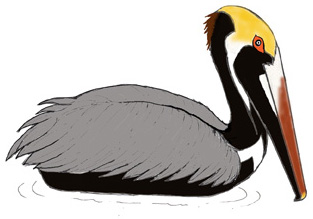

They breed from Maryland to Florida, Southern California and Texas south to South America. They winter along the coasts from central California and Virginia south to South America.
They live along the coast in warm places.
They are big birds, up to 4 feet long with a huge beak that has an expandable pouch for catching fish. They have a gray body, a yellow head and white neck and red skin around the eye.
They fly low over the water looking for fish. When they see them, they dive head first, into the water and catch them in the the beak pouch. Then they squeeze out all the water and eat the fish.
They mainly eat fish.
They build large nests of sticks on islands around other nesting birds. Female lays about 3 white eggs.
Kingdom: Animalia
Phylum: Chordata
Subphylum: Vetebrata
Class: Aves
Order: Pelecaniformes
Family: Pelecanidae
Genus: Pelecanus
Species: P. occidentalis
When you research information you must cite the reference. Citing for websites is different from citing from books, magazines and periodicals. The style of citing shown here is from the MLA Style Citations (Modern Language Association).
When citing a WEBSITE the general format is as follows.
Author Last Name, First Name(s). "Title: Subtitle of Part of Web Page, if appropriate." Title: Subtitle: Section of Page if appropriate. Sponsoring/Publishing Agency, If Given. Additional significant descriptive information. Date of Electronic Publication or other Date, such as Last Updated. Day Month Year of access < URL >.
Amsel, Sheri. "Pelican (Brown)" Exploring Nature Educational Resource ©2005-2024. December 14, 2024
< http://exploringnature.org/db/view/141 >

